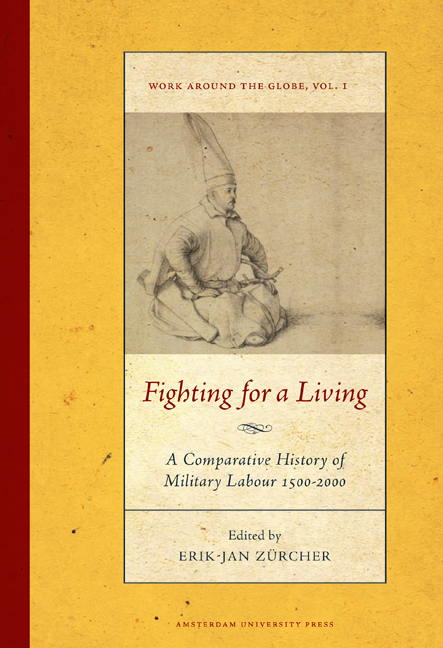Book contents
- Frontmatter
- Dedication
- Contents
- Preface
- Introduction: Understanding Changes in Military Recruitment and Employment Worldwide
- Military Labor in China, c. 1500
- From the Mamluks to the Mansabdars: A Social History of Military Service in South Asia, c. 1500 to c. 1650
- On the Ottoman Janissaries (Fourteenth-nineteenth Centuries)
- Soldiers in Western Europe, c. 1500-17901
- The Scottish Mercenary as a Migrant Labourer in Europe, 1550-1650
- Change and Continuity in Mercenary Armies: Central Europe, 1650-1750
- Peasants Fighting for a Living in Early Modern North India
- “True to Their Salt”: Mechanisms for Recruiting and Managing Military Labour in the Army of the East India Company During the Carnatic Wars in India
- “The Scum of Every County, the Refuse of Mankind”: Recruiting the British Army in the Eighteenth Century
- Mobilization of Warrior Populations in the Ottoman Context, 1750-1850
- Military Employment in Qing Dynasty China
- Military Service and the Russian Social Order, 1649-1861
- The French army, 1789-1914: Volunteers, Pressed Soldiers, and Conscripts
- The Dutch Army in Transition: From All-volunteer Force to Cadre-militia Army, 1795-1830
- The Draft and Draftees in Italy, 1861-1914
- Nation-building, War Experiences, and European Models: The Rejection of Conscription in Britain
- Mobilizing Military Labor in the Age of Total War: Ottoman Conscription Before and During the Great War
- Soldiering as Work: The All-volunteer Force in the United States
- Private Contractors in War From the 1990s to the Present: A Review Essay
- Collective Bibliography
- Notes on Contributors
Peasants Fighting for a Living in Early Modern North India
Published online by Cambridge University Press: 12 December 2020
- Frontmatter
- Dedication
- Contents
- Preface
- Introduction: Understanding Changes in Military Recruitment and Employment Worldwide
- Military Labor in China, c. 1500
- From the Mamluks to the Mansabdars: A Social History of Military Service in South Asia, c. 1500 to c. 1650
- On the Ottoman Janissaries (Fourteenth-nineteenth Centuries)
- Soldiers in Western Europe, c. 1500-17901
- The Scottish Mercenary as a Migrant Labourer in Europe, 1550-1650
- Change and Continuity in Mercenary Armies: Central Europe, 1650-1750
- Peasants Fighting for a Living in Early Modern North India
- “True to Their Salt”: Mechanisms for Recruiting and Managing Military Labour in the Army of the East India Company During the Carnatic Wars in India
- “The Scum of Every County, the Refuse of Mankind”: Recruiting the British Army in the Eighteenth Century
- Mobilization of Warrior Populations in the Ottoman Context, 1750-1850
- Military Employment in Qing Dynasty China
- Military Service and the Russian Social Order, 1649-1861
- The French army, 1789-1914: Volunteers, Pressed Soldiers, and Conscripts
- The Dutch Army in Transition: From All-volunteer Force to Cadre-militia Army, 1795-1830
- The Draft and Draftees in Italy, 1861-1914
- Nation-building, War Experiences, and European Models: The Rejection of Conscription in Britain
- Mobilizing Military Labor in the Age of Total War: Ottoman Conscription Before and During the Great War
- Soldiering as Work: The All-volunteer Force in the United States
- Private Contractors in War From the 1990s to the Present: A Review Essay
- Collective Bibliography
- Notes on Contributors
Summary
It is several years since historians have abandoned the idea of medieval and early modern India as a huge but static collection of economically self-sufficient and politically autonomous village units. With respect to large parts of India, another image has taken its place, that of a dual world, composed on the one hand of a sedentarized segment of settled, rain-fed agriculture and, on the other, one of mobile pastoralism in the arid half of the Indian subcontinent. The frontier between these worlds ran right across the subcontinent, though, rather than one frontier, the phenomenon consisted of a complex set of frontiers, frontier zones, and dynamic “inner frontiers” of exchange, intrusion, and negotiation linking and holding together vast regions bordering on them. In accepting this model, it should be noted that, on the one hand, cattle-based economies never existed independently from town and village markets, while, on the other hand, the political management of settled agriculture could not do without alliances with, or appeasement and employment of, pastoral warriors. On a more local level, village management often depended on either an annual exodus of seasonal labour and herders to grazing grounds during the post-harvest season or the engagement of mobile frontier manpower from outside during the busiest months of the year. Mobile labour, therefore, did not generally lack an agrarian base of some sort; neither were villagers unacquainted with faraway service, whether as weavers, herders, soldiers, or agricultural labourers. Also, a village's temporary diaspora would, if it appeared attractive to do so, lead to entire families settling down permanently in regions near or far. Landed communities would welcome in their midst families of relative strangers with their ploughs (a term for a pair of bullocks) from either the pastoral or the sedentarized worlds and integrate them in their systems of exchange of produce and division of labour. Military entrepreneurship by warlords often led to agrarian management rights in a number of villages (watan), mostly in or near their home region, being granted to them and their fighting men. More often than not, in one way or another, soldiering was an activity directly or indirectly supportive of agrarian pursuits.
This is especially the case in northern India, the part of the subcontinent to which my contribution restricts itself, just as the essay by Robert Johnson focuses on southern India.
- Type
- Chapter
- Information
- Fighting for a LivingA Comparative Study of Military Labour 1500–2000, pp. 243 - 266Publisher: Amsterdam University PressPrint publication year: 2013
- 1
- Cited by



